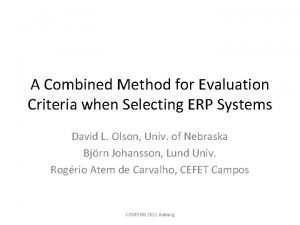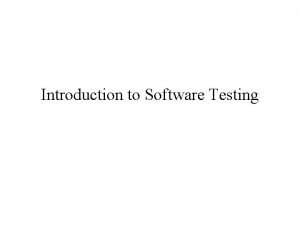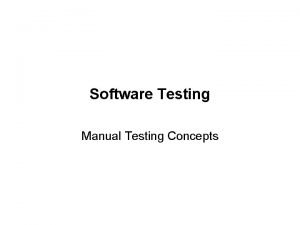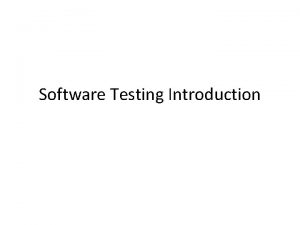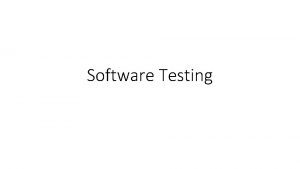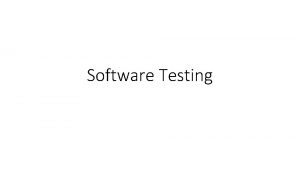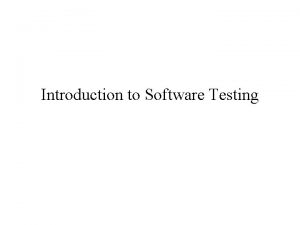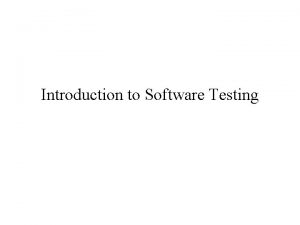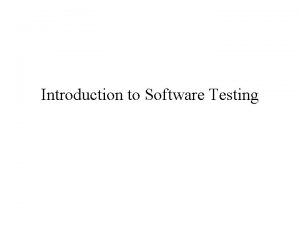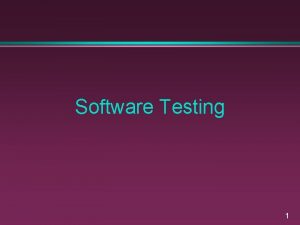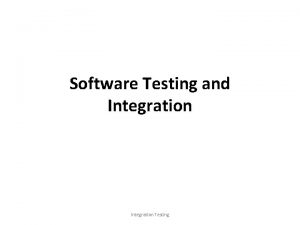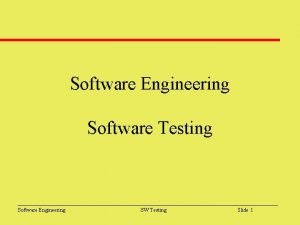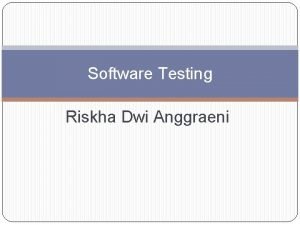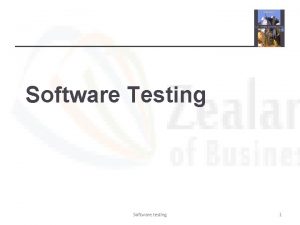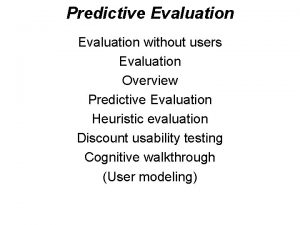Software Testing Software Testing Software Testing is evaluation




















- Slides: 20

Software Testing

Software Testing • Software Testing is evaluation of the software against requirements gathered from users and system specifications. • Testing is conducted at the phase level in software development life cycle or at module level in program code. • Software testing comprises of Validation and Verification. If you are a company programmer, why would you test software?

Software Validation • Validation is process of examining whether or not the software satisfies the user requirements. • It is carried out at the end of the SDLC. • If the software matches requirements for which it was made, it is validated. • Validation ensures the product under development is as per the user requirements. • Validation answers the question – "Are we developing the product which attempts all that user needs from this software ? ". • Validation emphasizes on user requirements.

Software Verification • The process of confirming if the software is meeting the business requirements, and is developed adhering to the proper specifications and methodologies. • Ensures the product being developed is according to design specifications. • Answers the question – "Are we developing this product by firmly following all design specifications ? " • Concentrates on the design and system specifications.


Software Verification • Target of the test are – – Errors • These are actual coding mistakes made by developers. In addition, there is a difference in output of software and desired output, is considered as an error. – Fault • When error exists fault occurs. A fault, also known as a bug, is a result of an error which can cause system to fail. – Failure • failure is said to be the inability of the system to perform the desired task. Failure occurs when fault exists in the system.

Manual Vs Automated Testing • Testing can either be done manually or using an automated testing tool: – Manual • The software tester prepares test cases for different sections and levels of the code, executes the tests and reports the result to the manager. • Manual testing is time and resource consuming. • The tester needs to confirm whether or not right test cases are used. • Major portion of testing involves manual testing. – Automated • This testing is a testing procedure done with aid of automated testing tools. Such as Junit. (JUnit is an open source Unit Testing Framework for JAVA. It is useful for Java Developers to write and run repeatable tests. ) • The limitations with manual testing can be overcome using automated test tools. – Examples • A test needs to check if a webpage can be opened in Internet Explorer. – This can be easily done with manual testing. • To check if the web-server can take the load of 1 million users. – It is quite impossible to test manually.

Testing Approaches: Black-box testing • It is carried out to test functionality of the program and also called ‘Behavioral’ testing. • The tester in this case, has a set of input values and respective desired results. • On providing input, if the output matches with the desired results, the program is tested ‘ok’, and problematic otherwise. • In this testing method, the design and structure of the code are not known to the tester, and testing engineers and end users conduct this test on the software.

Testing Approaches: White-box testing • It is conducted to test program and its implementation, in order to improve code efficiency or structure. • It is also known as ‘Structural’ testing. • In this testing method, the design and structure of the code are known to the tester. Programmers of the code conduct this test on the

Testing Levels • Testing itself may be defined at various levels of SDLC. • The testing process runs parallel to software development. • Before jumping on the next stage, a stage is tested, validated and verified. • Testing separately is done just to make sure that there are no hidden bugs or issues left in the software.

Unit Testing • While coding, the programmer performs some tests on that unit of program to know if it is error free. • Testing is performed under white-box testing approach. • Unit testing helps developers decide that individual units of the program are working as per requirement and are error free.

Integration Testing • Even if the units of software working fine individually, there is a need to find out if the units if integrated together would also work without errors. • For example, argument passing and data updating

System Testing • The software is compiled as product and then it is tested as a whole. • This can be accomplished using one or more of the following tests: – Functionality testing - Tests all functionalities of the software against the requirement. – Performance testing - This test proves how efficient the software is. It tests the effectiveness and average time taken by the software to do desired task. Performance testing is done by means of load testing and stress testing where the software is put under high user and data load under various environment conditions. – Security & Portability - These tests are done when the software is meant to work on various platforms and accessed by number of persons.

System and Integration Testing System Integration Testing is usually performed on subset of system while system testing is performed on a complete system

Acceptance Testing • When the software is ready to hand over to the customer it has to go through last phase of testing where it is tested for user-interaction and response. • This is important because even if the software matches all user requirements and if user does not like the way it appears or works, it may be rejected. – Alpha testing - The team of developers use the system as if it is being used in work environment. They try to find out how user would react to some action in software and how the system should respond to inputs. – Beta testing - After the software is tested internally, it is handed over to the users to use it under their production environment only for testing purpose. This is not as yet the delivered product. Developers expect that users at this stage will bring minute problems, which were skipped to attend.

Regression Testing • Whenever a software product is updated with new code, feature or functionality, it is tested thoroughly to detect if there is any negative impact of the added code. This is known as regression testing.

Testing vs. Software Quality Assurance • We need to understand that software testing is different from software quality assurance, software quality control and software auditing. • Software quality assurance – Means by which it is assured that all the measures are taken as per the standards of organization. – This monitoring is done to make sure that proper software development methods were followed.

Testing vs. Software Quality Control • Software quality control – System to maintain the quality of software product. – It may include functional and non-functional aspects of software product, which enhance the goodwill of the organization. – This system makes sure that the customer is receiving quality product for their requirement and the product certified as ‘fit for use’.

Testing vs. Software Audit • Software audit – This is a review of procedure used by the organization to develop the software. – A team of auditors, independent of development team examines the software process, procedure, requirements and other aspects of SDLC. – The purpose of software audit is to check that software and its development process, both conform standards, rules and regulations.

When do you stop testing?
 What is domain
What is domain Motivational overview in software testing
Motivational overview in software testing Du path testing
Du path testing What is globalization testing
What is globalization testing Cause effect graphing technique
Cause effect graphing technique Control structure testing in software engineering
Control structure testing in software engineering Decision table testing in software testing
Decision table testing in software testing Decision table testing examples
Decision table testing examples Extended entry decision table
Extended entry decision table Rigorous testing in software testing
Rigorous testing in software testing Testing blindness in software testing
Testing blindness in software testing Software testing domains
Software testing domains Functional evaluation of pavement
Functional evaluation of pavement Project evaluation in software project management
Project evaluation in software project management Erp selection methods and criteria
Erp selection methods and criteria Randa tower
Randa tower Student evaluation software
Student evaluation software Positive and negative testing
Positive and negative testing Cs3250
Cs3250 Neighborhood integration testing
Neighborhood integration testing Black-box testing disebut juga sebagai behavioral testing
Black-box testing disebut juga sebagai behavioral testing














